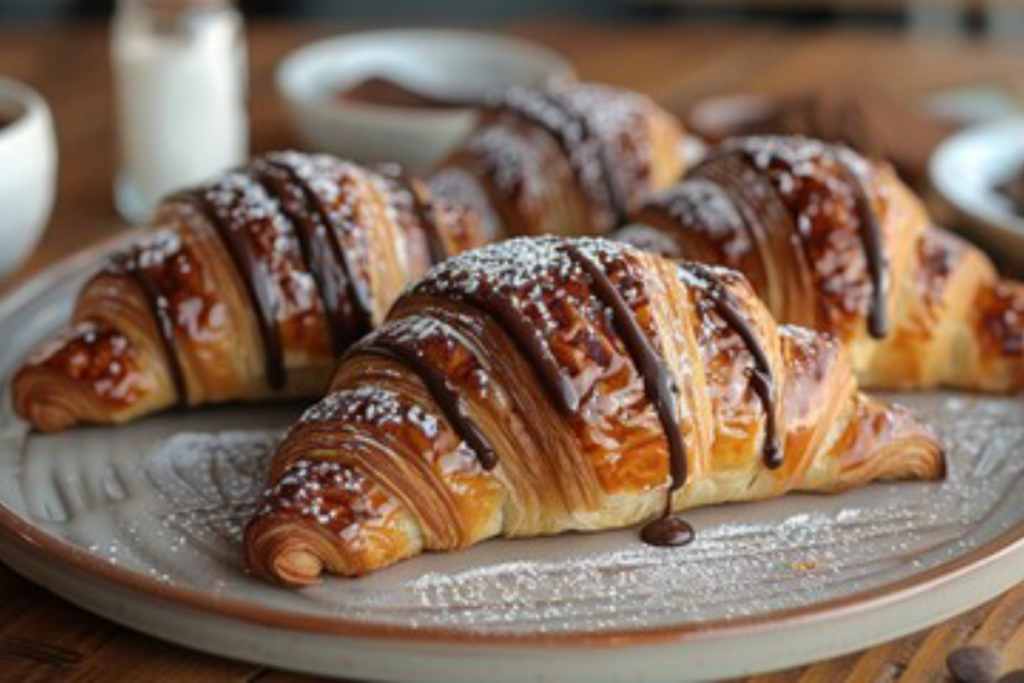When it comes to breakfast pastries, few are as beloved as the buttery croissant and the Swiss gipfeli. While they may seem similar at first glance, there are distinct differences that set them apart. Understanding the difference between a croissant and a gipfeli opens up a world of culinary diversity, showcasing two pastries that reflect the cultures from which they originate.
In this in-depth guide, we’ll explore everything you need to know about croissants and gipfelis. From their origins and ingredients to their unique textures and flavors, you’ll discover the key elements that make each of these pastries special.
Origins of the Croissant and Gipfeli
To understand the difference between a croissant and a gipfeli, it’s helpful to start with their origins. Though they share some similarities, these two pastries come from distinct culinary traditions.
The History of the Croissant
The croissant is one of the most iconic French pastries, but its origins are often linked to Austria. The story begins in Vienna in the late 17th century, when the city was under siege by the Ottoman Empire. Legend has it that after the siege was successfully repelled, a local baker created a pastry shaped like the crescent moon—symbolizing the Ottoman flag—as a way to celebrate victory. This pastry, known as the kipferl, eventually made its way to France, where it was transformed into the flaky, buttery croissant we know today.
By the early 20th century, croissants had become a staple of French bakeries and breakfast tables. The croissant’s rise to global fame can be attributed to its delicate, flaky layers and rich buttery flavor, making it a favorite among pastry lovers worldwide.
The Story Behind the Gipfeli
The gipfeli, on the other hand, has its roots in Switzerland. Like the croissant, it evolved from the Austrian kipferl but took on a different form and texture as it was adapted to Swiss tastes. While the croissant became famous for its rich, flaky texture, the gipfeli developed a denser and less buttery consistency, reflecting the Swiss preference for a more straightforward pastry.
Though it shares a similar crescent shape with the croissant, the gipfeli is not as flaky or buttery. In Switzerland, gipfeli are often enjoyed at breakfast or as a snack, and they are seen as a more understated, everyday pastry compared to the croissant’s luxurious reputation.
Key Differences Between a Croissant and a Gipfeli
Though they may look alike at first glance, the difference between a croissant and a gipfeli is apparent in several key areas, including ingredients, preparation, texture, and flavor.
Ingredients
One of the biggest differences between a croissant and a gipfeli lies in their ingredients. Both pastries use similar base ingredients such as flour, yeast, milk, and butter, but the proportions and types of ingredients differ, resulting in distinct flavors and textures.
Croissant Ingredients:
- Butter: French croissants are renowned for their high butter content, which is responsible for the pastry’s rich flavor and flaky texture. The butter is folded into the dough through a process called lamination, which creates layers.
- Flour: Croissants typically use all-purpose flour or bread flour, giving them a lighter, airier texture.
- Milk or Water: The liquid used in croissant dough is often milk, which adds a slight richness.
- Sugar: Croissants usually contain a small amount of sugar to balance the savory and sweet flavors.

Gipfeli Ingredients:
- Butter or Margarine: Unlike the croissant, which is made exclusively with butter, gipfeli can be made with butter or margarine. This gives the gipfeli a slightly less rich flavor.
- Flour: Swiss gipfeli tend to use a more robust flour, which contributes to their denser texture.
- Milk or Water: Like croissants, gipfeli can be made with milk, though water is often used in simpler versions.
- Less Sugar: The Swiss gipfeli typically contains less sugar than the croissant, resulting in a more neutral taste.
Preparation
Another crucial difference between a croissant and a gipfeli is how they are prepared. The croissant is a laminated pastry, while the gipfeli is not. This difference in technique leads to their varying textures.

How Croissants Are Made:
The hallmark of a croissant is its layers, which are created through a process called lamination. Lamination involves folding butter into the dough multiple times, creating alternating layers of dough and butter. When baked, the moisture in the butter turns to steam, causing the layers to separate and creating the croissant’s signature flaky texture.
How Gipfeli Are Made:
Gipfeli dough, on the other hand, is not laminated. Instead, the dough is rolled out, shaped into crescents, and baked. This simpler preparation method results in a pastry that is denser and less flaky than a croissant. The lack of lamination also means that gipfeli have fewer layers and a more uniform, compact crumb.
Texture and Flavor
Perhaps the most noticeable difference between a croissant and a gipfeli is in their texture and flavor. Both pastries have their own unique appeal, but they cater to different preferences.
The Texture of a Croissant
Croissants are known for their light, airy, and flaky texture. When you bite into a well-made croissant, you experience a delicate crispiness on the outside, followed by soft, buttery layers on the inside. This texture is a direct result of the lamination process, which creates pockets of air between the layers of dough.
The flavor of a croissant is rich and buttery, with a hint of sweetness. The high butter content gives it a luxurious taste that melts in your mouth. This combination of buttery flavor and flaky texture is what makes the croissant such a beloved pastry.
The Texture of a Gipfeli
By contrast, the gipfeli has a denser, less flaky texture. It’s still soft, but without the delicate layers of a croissant. The exterior of a gipfeli is typically more chewy, and the crumb is uniform throughout. This makes the gipfeli a more robust pastry that holds up well when paired with spreads or eaten on its own.
In terms of flavor, the gipfeli is less buttery than a croissant. Depending on whether it’s made with butter or margarine, the flavor can be more neutral, making it a versatile choice for both sweet and savory fillings. Some versions of gipfeli are also less sweet, which makes them suitable for a variety of breakfast spreads or snacks.
The Role of Butter in Croissants vs. Gipfeli
One of the most significant factors that contributes to the difference between a croissant and a gipfeli is the amount and quality of butter used in each pastry.
Butter in Croissants
Butter plays a crucial role in the making of croissants. The lamination process relies on high-quality butter to create the delicate layers of dough, and it’s this butter that gives croissants their rich, melt-in-your-mouth flavor. In fact, the success of a croissant depends heavily on the quality of the butter used. Authentic French croissants use European-style butter, which has a higher fat content and less water, resulting in a superior texture and taste.
Butter or Margarine in Gipfeli
Gipfeli, on the other hand, don’t rely as heavily on butter for their texture or flavor. While butter can be used, it’s not always essential, and some recipes even call for margarine. This substitution makes gipfeli less rich and less flaky than croissants, but it also gives them a sturdier texture that’s well-suited for everyday consumption.
Shape and Appearance
Though croissants and gipfeli share a similar crescent shape, there are subtle differences in their appearance that set them apart.
Croissant Shape and Look
Croissants are typically larger and more elongated than gipfeli. They have a smooth, shiny surface that often shows the distinct layers of dough created by the lamination process. The ends of the crescent are usually thinner and crispier, while the middle remains soft and tender.
Gipfeli Shape and Look
Gipfeli, by contrast, are often smaller and more compact. Their shape is less uniform, and they tend to have a slightly thicker, more solid appearance. The surface of a gipfeli may be less shiny than a croissant, and because the dough isn’t laminated, you won’t see the same visible layers.
Serving Suggestions
Both croissants and gipfeli are delicious on their own, but they can also be paired with various spreads, fillings, or accompaniments to enhance their flavors.
How to Serve Croissants
Croissants are often enjoyed plain or with simple spreads like butter, jam, or chocolate. However, they can also be transformed into decadent breakfast sandwiches filled with ham and cheese, or even served with eggs for a more substantial meal. Croissants can also be filled with almond paste or chocolate for a sweet treat.
How to Serve Gipfeli
Gipfeli are usually eaten plain or with a light spread of butter, honey, or jam. In Switzerland, it’s common to enjoy a gipfeli alongside a cup of coffee or tea. Because they are less rich than croissants, gipfeli are also a great base for savory fillings, such as cheese or cold cuts.
Conclusion: Understanding the Difference Between a Croissant and a Gipfeli
At first glance, the croissant and the gipfeli may seem like close relatives, but upon closer inspection, the difference between a croissant and a gipfeli becomes clear. From their ingredients and preparation methods to their textures and flavors, these two pastries offer distinct culinary experiences.
The croissant is known for its rich, buttery flavor and flaky layers, making it a luxurious treat. In contrast, the gipfeli offers a denser, more straightforward pastry that’s perfect for everyday enjoyment. Whether you prefer the decadent richness of a croissant or the simple charm of a gipfeli, both pastries hold a special place in the world of baked goods.
Now that you understand the difference between a croissant and a gipfeli, you can appreciate the unique qualities of each and enjoy them for what they truly are: two delicious pastries with their own distinct identities.
